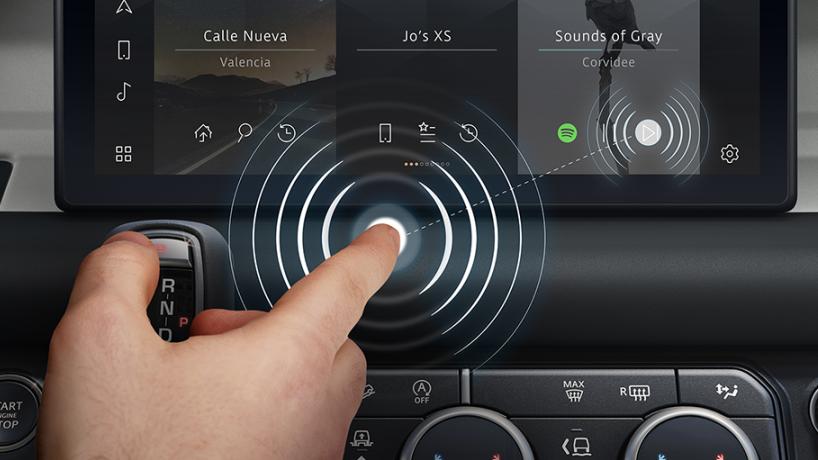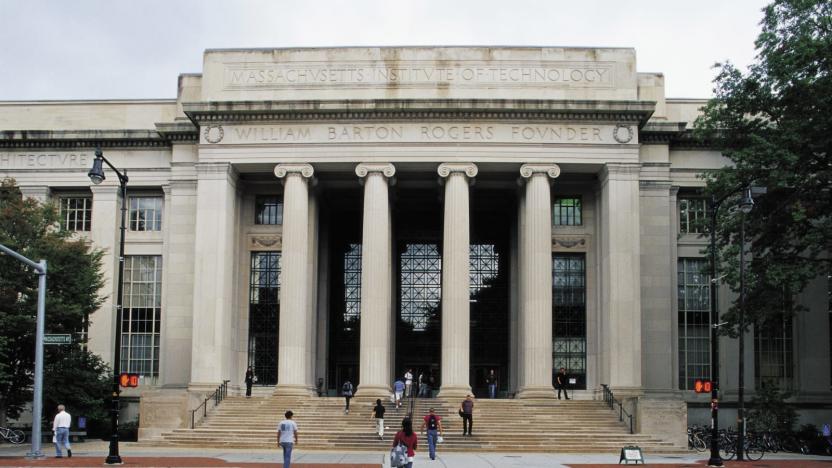cambridgeuniversity
Latest

Jaguar Land Rover shows off AI-powered 'no-touch touchscreen' for cars
The AI system uses sensors and context to figure out which button you want to tap.

Cambridge researcher claims no 'misuse' of data after Facebook ban
Yesterday, Facebook announced that it had banned the Cambridge University app myPersonality, which was collected user data for academic and research purposes. Facebook claimed it banned the app for two reasons: the creator refused to an audit and the researchers shared personal information with few protections in place. Now, Dr. David Stillwell at Cambridge University has provided a scathing statement about Facebook's actions to Engadget.

Facebook audit leads to the suspension of 400 apps
In May a report by New Scientist revealed that a Cambridge University-developed app called "myPersonality" had collected personal information from millions of Facebook users, and failed to protect it from misuse. At the time, Facebook said it had already suspended the app for passing data to others, and today said it was banned "for failing to agree to our request to audit and because it's clear that they shared information with researchers as well as companies with only limited protections in place." The researchers behind the project have posted an FAQ here, mentioning that their research has been used in dozens of peer-reviews papers and saying much of it focused on exposing privacy risks. The data is no longer shared, and in a statement, the university's Psychometric Centre said it had never collected info from user's friends.

Amazon's Alexa Fellowship expands to 14 more universities
Amazon is eager to get more bright minds working on voice technology, so it's expanding the Alexa Fellowship program to 14 more universities, including Massachusetts Institute of Technology, Texas A&M and Cambridge. The fellowships are financed through Amazon's $200 million Alexa Fund.

Milky Way's fastest stars could be runaways from another galaxy
The fastest-moving stars in our galaxy, known as hypervelocity stars, may have a more interesting backstory than scientists first thought, according to new research from Cambridge University. Astronomers initially believed these super-rare stars -- only 20 have been identified -- had been expelled from the center of the Milky Way by a supermassive black hole, but the study shows that they may have started their breakneck journeys in another galaxy altogether: the Large Magellanic Cloud (LMC).

ICYMI: Pig poop could make more eco-friendly roadways
try{document.getElementById("aol-cms-player-1").style.display="none";}catch(e){}Today on In Case You Missed It: The chemical makeup of pig manure is so similar to petroleum that it's being tested as a more bio-friendly way to make asphalt roads, while the leftover bits can be used as fertilizer. Since pigs already produce 43 billion gallons of manure each year, re-using some for road construction might be the smartest thing we've done with bioengineering yet. You can find our diabetes story from Cambridge here, the first banking chatbot from Kasisto here, and the selfie drone that's going to be everywhere, here. As always, please share any interesting tech or science videos you find by using the #ICYMI hashtag on Twitter for @mskerryd

ICYMI: Pollution sea vacuum, SpaceX's success and more
#fivemin-widget-blogsmith-image-999936{display:none;} .cke_show_borders #fivemin-widget-blogsmith-image-999936, #postcontentcontainer #fivemin-widget-blogsmith-image-999936{width:570px;display:block;}try{document.getElementById("fivemin-widget-blogsmith-image-999936").style.display="none";}catch(e){}Today on In Case You Missed It: SpaceX successfully landed its reusable rocket, from a height of 125 miles-- then Elon Musk and Blue Origin CEO Jeff Bezos traded Twitter jabs for our entertainment. Scientists from Cambridge University found that oil droplets change into artificial shapes like octagons when frozen in soapy water, then return to their normal shape when heated. And a nearly $4,000 gadget for sailors aims to clean up the dirty marinas where debris and oil spills often mar the seafaring beauty.

ICYMI: Far away haptic hello, birthing robot mom and more
#fivemin-widget-blogsmith-image-3569{display:none;} .cke_show_borders #fivemin-widget-blogsmith-image-3569, #postcontentcontainer #fivemin-widget-blogsmith-image-3569{width:570px;display:block;} try{document.getElementById("fivemin-widget-blogsmith-image-3569").style.display="none";}catch(e){}Today on In Case You Missed It: The Haptoclone allows users to touch and interact with distant objects, in a way you have to see to understand. But basically, long-distance makeouts over Skype are coming. Cambridge University researchers designed a robot that can make it's own 'children,' then test them for the strongest features, to then incorporate for the following generation. And the FIA Formula E Championship (the E is for electricity-based power) just showcased its new cars for the start of its second official season.

Cambridge University opening Graphene Centre to take material 'to the next level'
As a quick glimpse of research in recent years will show you, there's seemingly no limit to what graphene can do. The carbon-based substance has largely remained the realm of the laboratory, but Cambridge is amongst those universities looking to help the amazing substance play a bigger role in industry. As part of its efforts, the school is set to start work on the Graphene Center at the beginning of next month, a facility that's set to "take graphene to the next level" when it opens shop by year's end, with the help of a £12 million ($19 million) grant. Scientists at the center will seek to harness the material to help create things like flexible, transparent electronics, networked devices and energy storage for electric cars. More information on the forthcoming recearch center can be found in the source link below.

Quantum cryptography keys ride the lightning on existing fiber lines
Quantum computing has teased us with its potential for some time, but we won't be seeing qubits in our laptops anytime soon. However, science has also sought to leverage quantum physics in cryptography, and a recent breakthrough will allow for quantum encryption over fiber optic cables already in use. Researchers from Toshiba and Cambridge University discovered that they could transmit and receive encryption keys using pulses of quantum light and a specialized photodetector. The trick was to build a detector with a gate capable of both sensing a single photon and opening for just one tenth of one billionth of a second at the precise time that the photon arrives. Knowing the timing of the photon's arrival with such precision allows the quantum light to be captured and filtered out from other light pulses carrying regular data in the cable. Why all the effort to use quantum light? Well, if any quantum photon carrying an encryption key is intercepted during transmission, it's permanently changed. This, in turn, alerts those intended to receive the info that the encryption key may have been compromised. Previously, quantum encryption keys could be exchanged, but only if sent using a dedicated fiber line, which isn't a cost-effective solution. This new method allows keys to be sent via existing lines already in operation transmitting data, so no dedicated fiber need be installed. In testing, simultaneous 1 Mbps quantum key data rates and 1 Gbps regular data rates were achieved, and one researcher told BBC News that the technology is "not too far away" from being used to secure financial networks. For now, the new quantum key distribution method remains in the lab, but you can read all about it at the source below.

Cambridge University helps new Raspberry Pi users break the crust with free guide, tutorials
It all looks so simple, doesn't it? A little board, a cute name -- why, you'll be up and robot-ing in no time, right? Well, just ask one of our techiest editors, who tried to learn a similar product, the Arduino -- and failed -- boards like the Pi are not cake. So, to push you in the right direction, Cambridge University is offering a free guide to creating a simple OS for the device called "Baking Pi." It's part of a course for new students of the institution's computer lab (who each get a Pi as part of their tuition), but the guide and a tutorial series are free to the public, as well. Programming experience is not required "if you are smart and persistent," but it will certainly be easier if you have some, according to the Pi website. The campus, which is the seat of the Raspberry Pi Foundation, certainly has a vested interest in getting new coders to the board -- not that they need to create any more demand. Check the source and coverage below for the guide and tutorials. [Image credit: Mark Foss]

Sir Isaac Newton's notes get a digital makeover, coming to a browser near you
It isn't a rarity for the folks at the University of Cambridge to introduce us to some of their digital findings, and on this occasion they are delivering 4,000 of Newton's manuscripts right to your virtual door. These gems are part of an abundant collection of over 12,000 handwritten notes and hardcovers that the University holds under possession -- the plan is to make the entire selection digitally available "over the next few months." Amongst the scanned documents, you'll be able to find a plethora of his genius scribbles stamped on books that were used during his theory process, some of which are: Trinity College Notebook, Waste Book and the famed Principia Mathematica. Who said an OS would be Newton's only way through a mainframe?

Scientists manipulate electron, this time everyone wins
Notoriously difficult to pin down, electrons have always been free spirits -- until now that is. According to a paper published by science journal Nature, folk at Cambridge University much cleverer than we have tamed single electrons, succeeding in coaxing them directly from point-to-point. The technique involves creating a small hole in gallium arsenide, called a "quantum dot," then creating a channel of energy higher than the neighboring electrons to shuttle cargo off to another empty "dot." Why should you care? Well, while you might not see this technology in the next smartphone, it should give quantum computing a bit of a nudge forward, smoothing the rate of information transfer. If the concept works out, it'll improve the way qubits move around those sub-atomic circuits, where jumping around like a frog in a sock is generally considered bad form. [Image courtesy of the io9]

Cambridge researchers tout new location-based method to predict friends on social networks
Friend suggestions on social networks may already be a little too eerily accurate for some, but a team of researchers from Cambridge University now say they can do one better. They've devised a method that doesn't simply rely the usual friends-of-friends approach, but on where those people tend to hang out. According to researcher Salvatore Scellato, "it turns out that the properties of the places we interact can determine how likely we are to develop social ties," and that places like offices and gyms are better indications of potential friends than football stadiums or airports. That notion was borne out in their research (conducted over a period of four months using Gowalla), which found that "about 30 percent of all new social links appear among users that check-in to the same places." With the two prediction methods combined, the researchers say they're able to account for 66 percent of all new social ties. No word if they've moved onto predicting crimes next. [Image credit: Gowalla]

A grand tour of nanotechnology at Nokia Research Center, Cambridge
We've all seen what a bumpy ride Nokia's had over the last few months -- disappointing profits, the departure of a couple of old friends, and the slight delay of the forthcoming N8. Despite all that, Espoo seems to have at least one stronghold that remained unshaken throughout the storm: its research center in Cambridge, UK. Yep, we're talking about the magical place where Nokia and University of Cambridge co-develop the core technologies for the futuristic Morph concept. Actually, "futuristic" might be too strong a word here, as we were fortunate enough to see some of Nokia's latest research at the heart of Morph -- namely flexible circuitry and nanowire sensing -- demonstrated live yesterday. Curious as to how well the demos went? Then read on -- you know you want to.%Gallery-103427%

Cambridge scientists develop lower-than-low power WORM memory
Researchers at Cambridge University have recently published a paper on their new type of WORM (write once read many) memory which is even more low powered than the ones that came before it. The new electron-only design of the memory is solution processed, making it low cost as well as it requires no lithography. The device, using ZnO semiconductor nanoparticles to inject electrons into a polymer which is capable of conducting. The electrons are then used to program the memory by permanently lowering the conductivity of the polymer, producing insulation. This result is far lower power densities than previously recorded, by orders of magnitude. The research team believes that it can make further improvements to the device as they continue to work.

Research team "near production" of a cheap lightbulb, lasts up to 60 years
We've seen plenty of high-efficiency lightbulbs rolling around, but this new one -- if it ever sees the light of day (groan) -- has impressive potential. Cambridge University's team of researchers are apparently quite close to bringing to production an LED bulb that can last up to 100,000 hours (about 60 years), and which -- unlike some other eco-friendly lighting -- contains no mercury. In the UK, where sale of some incandescents has been phased out, the team estimates they could reduce carbon emissions by about 40 million tons. The team has also significantly cheapened production by growing the LEDs on silicon wafers rather than the sapphire ones normally used, thereby bring the cost to... wait for it: $2.85. So when can we expect to see these badboys on the market? "Soon." [Via Switched]

"Silent jet" will make airports quieter, prove dangerous to Superman
In a breakthrough that's being touted as a potentially crushing blow to the noise-canceling headphone industry, researchers at MIT and Cambridge University have designed a unique passenger jet that reportedly sounds no louder than a washing machine from outside the confines of an airport. The so-called Silent Aircraft Initiative -- which began in November 2003 -- culminates today with the unveiling of a concept plane which is roughly the size of a Boeing 767, but takes its design cues from stealth military jets like the B-2 bomber, in that its fuselage has been "squished" to create an all-lifting body. Besides re-imagining the shape of traditional jumbo jets, the 40-person team also moved the engines from under the wings into the body of the plane itself, allowing them to take in air from the top of the wing and minimize the noise heard by people on the ground. The quieter design could result in airports being constructed much closer to residential areas, meaning that passengers would be able to start their two-hour wait at the security checkpoint that much more quickly. While specific noise-dampening elements of the airplane will probably be implemented into passenger jets in the near future, the SAI researchers believe we won't see the concept itself in flight until sometime around 2030 -- a little too late, in our opinion, as we're pretty sure that teleportation will completely obviate the need for air travel long before then.[Via Reuters, illustration courtesy of CNET]











